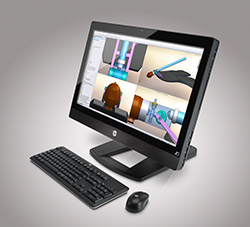HP Z1 Workstation

 First All-In-One Workstation
First All-In-One Workstation
No oops about it, HP has done it again with the introduction of the Z1 Workstation. The engineering behind the first all-in-one workstation-class computer is nothing short of amazing. Designed specifically for professionals in the graphics, photography, video, and CAD industries, the Z1 sports a beautiful 27″, billion-color display with a maximum resolution of 2560×1440. Touchscreen capability would complete the display nicely.
The entire unit folds flat and the screen flips open, granting users access under the hood. The tool-less design from previous Z Workstation models is carried over to most of the major components, making upgrades child's play. (Do not attempt with an iMac—sorry Apple fans.)
Available processors range from the Intel Core i3-2120 to the Intel Xeon E3-1280, and graphics cards range from integrated Intel HD Graphics 2000 to the NVIDIA Quadro 4000M (MXM form factor). For obvious reasons, if budget allows, the Intel Xeon processor and NVIDIA Quadro 4000M is the best combination. Users have the option of one 3.5″ SATA 7,200 RPM drive, two 2.5″ SATA 10K RPM drives, or two 2.5″ SATA solid state drives supporting RAID 0, 1 configuration.
Up to 32 GB of unbuffered DDR3 ECC and 8 GB of nECC DDR3 RAM is supported in four DIMM slots. Additionally, there are three mini-PCIe slots (one being occupied by a wireless card), an internal USB 2 port, a full 1080p webcam, four SRS speakers, and a choice of either a slot-load Blu-ray writer or slot-load DVD+/-RW.
Another carryover from previous models is separation of major components into four zones coupled with fans to disperse heat. The fans are energy efficient and whisper quiet, keeping in step with HP's commitment to being an environmental leader.
External ports on the side feature two USB 3, one FireWire 400, one multiformat media card reader, and audio in and out. Ports on the back include four USB 2, audio in and out with S/PDIF, Ethernet, and display port. The display port can toggle between input and output, allowing a dual monitor setup or using the unit as a display only (although I'm not sure what the practical application of the latter situation would be). The location of the back ports is one of the few missteps in design, as they are awkward to reach when plugging in devices.
The stand, while simplistic in nature, is sturdy enough to support the near 50 lbs of hardware tucked into the chassis. The hinged, folding design is what allows the unit to lay flat when performing upgrades. The one-button release is easy to operate; however, bringing the unit back into the full upright position seemed a bit stiff. Once in the upright position, the unit has a tilt of about 25° and has approximately 4″ of vertical adjustment. If desired, the stand can be removed and the workstation can be attached to any standard VESA mount.
Along with all of the phenomenal engineering to cram this much power into an all-in-one unit, HP includes software such as Remote Graphics Software, allowing users to access their content from any computer and collaborate on 3D projects in real time across a network. Also, as the name suggests, HP Performance Advisor allows users to quickly and easily monitor performance, as well as identify any bottlenecks within the system.
Expect power and performance in a sleek, sexy, and easily accessible chassis that will make all the diehard Apple fans sit up and take notice. The Z1 Workstation is available starting at $1,899 with fully customizable options. (For benchmark results, visit http://members.photoshopuser.com/article/hp-z1-review.)
Company: HP
Price: $5,673 (tested configuration)
Web: www.hp.com/z1
Rating: 4.5
Hot: High performance; easy to upgrade
Not: No touchscreen capability; poor placement of back ports
